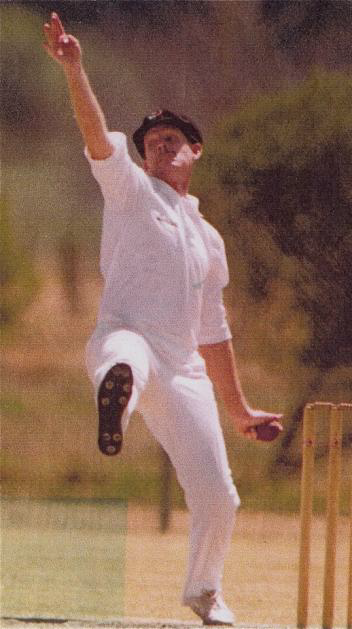Paul Thomas - Penrith first grade cap No 79
Penrith Cricket Club | March 12, 2023

When he retired Paul Thomas had taken 687 wickets for Penrith, the Club’s highest wicket-taker. We can add to that: took five-wickets-in-an-innings 28 times. But, these are just a beautiful set of numbers. It’s the character of the cricketer, and the patient manner in which he negotiated his career path, that makes ‘Thommo’ an ideal role model for aspiring young cricketers, especially spin bowlers. It was a pathway with the occasional bump. As a young boy he idolised the left-arm swing bowling of the great Australian all-rounder Gary Gilmour, and bowled it for St Dominics. “There was not a lot of power in my slight frame and Bob and I soon realised there was no future in it.”
Bob was his father, later to become the Club’s long-term Treasurer. “Bob lugged me down on the train to the SCG to watch the occasional Aussie Test match. I remember England’s Derek Underwood and India’s Bishen Bedi. I admired Underwood for his accuracy and his competiveness, and, Bedi for his flight and guile, a much underrated spin bowler in my mind.” So, it was no surprise that when young Paul came to Penrith Green Shield in 1978/79, a member of a Premiership-winning Emu Plains CC, he had morphed into a left-arm slow bowler. The next summer he was graded Fourths.
“I honestly don’t recall ever spinning the ball much at that time,” he says. Nor was he as athletically gifted as some. A future team mate, Paul Goldsmith, would say of his fielding: “Thommo, you’ve got hands like cymbals.” When he batted it was at No.11, rated a ‘bunny’ by his opponents. He concedes: “I was conscious of the fact that I didn’t have the athletic prowess of a Trevor Bayliss, a Brian Wood or a Dale Turner.” But he was able to offset that with deep reserves of perseverance and intelligence. “I did spend hours in the nets ensuring that I had the fitness and the stamina to bowl long spells whenever the captain required,” he says. In the 1990/91 season, by then an established First Grader, when Manly made 8/232 he took all eight wickets. That’s notable, but so is this: he bowled an incredible spell of 38.5 overs!
His apprenticeship was a long one. One incident serves as a reminder to cricket coaches who idolise textbook style as the only foundation for success. “Although Bob tried hard in the early years I was self-taught for the most part. I once attended a Specialist Spin Skill Course convened by the NSWCA Coaching Panel at Narrabeen Sport & Recreation Camp. I had a hard time of it. In the end I had no alternative other than to develop my own style.”
Image - After the 1982/83 season, the Club’s Special Events Committee organised a Tenth Anniversary Dinner and Presentation night at the Nepean Rowing Club. A Player of the Round was a young and dapper Paul Thomas, who received congratulations, and an ‘envelope’ from President Bill Ball. In Round five against Sutherland he took 6/30 and 2/25, and, possibly surprising to those with no confidence in his batting, he scored an unbeaten 39. Scores: Penrith 279, Sutherland 119 and 5/151.
He stuck at that apprenticeship. “I wanted to be the best possible player I could be if and when my First Grade chance arrived. I attended practice religiously. I hoped the top spinners Ken Hall and Gary Donlan would have the spare time to assist me in becoming a better bowler. ‘Emu’ (Ken Hall) was one of the finest players I ever encountered—tough, competitive and relentless, never gave up. I have a soft spot for Emu as it was through his leaving our great Club that my opportunity arose.”
Paul Thomas would spend five seasons in Second Grade. “I never felt frustrated but channelled my energies into enjoying the company of those around me. I was often one of the last to leave the clubhouse. Any thoughts of leaving for another Club were quickly dismissed as I always aspired to be a one-Club player … and anyway, Bob would have none of that!” He went into First Grade in 1988/89, at the age of 25, when Emu joined the newly-formed Hawkesbury Club.
In sporting jargon, he had been presented with ‘a hard act to follow’; however, once confident about his place in the team, and, through persistence at practice and watching, listening and learning from match experiences, he developed subtlety and guile, and, the skill of picking a batsman’s weakness, of getting the ‘crucial’ wicket. “I remember once being told at practice to ‘get the ball above the level of the batsman’s eyes’ as this was a sure fire way to force a batsman into potential judgemental errors. Greg Matthews was a great exponent of this and I witnessed him destroy our First Grade side on several occasions.”
A spinner needs a thick skin and plenty of patience. “Scott Thompson from Bankstown took a liking to my bowling. There was never a boundary that he didn’t succeed in clearing. His wicket was always elusive for me. Another former NSW player Phil Marks was different again. In one of our early meetings he had proclaimed, ‘Thommo, you will never get me out!’ I always felt I was a chance and on our sixth meeting I captured his wicket. Very satisfying.” Any spinner also needs a captain with courage, and encouragement. “Every time I went for a six Trevor Bayliss always felt that we were just that little bit closer to taking the batsman’s wicket, all that was needed was a bit more guile, or flight, or change of pace. Many a wicket was taken with a stumping or a skied catch from a batsman attempting another big shot!”
In Sydney First Grade there have not been many with numbers like Paul Thomas. Against Mosman at Howell Oval in 1994/95 Thommo took 15/55 (8 for 33 and 7 for 22), the eighth-best match figures in the history of Sydney First Grade. He took 54 wickets in 1994/95, when the best was 57. He was leading wicket-taker in 1996/7 with 56. It begs the question, why didn’t he get the call from the State selectors? “I would have relished the chance to play at least a Second XI game for NSW. I was selected twice to play for a Combined Sydney XI at the SCG against a Combined Services XI and a Sydney Shires XI respectively, taking four wickets both times.”
Certainly not much joy there, however Thommo did pass with distinction other cricketing markers: retain your sense of humour, never take yourself too seriously, love the game, and, support your Club. Thommo On Fielding—“As I bowled very slow and very straight, more often than not many hard hit chances came my way and at times my hands let me down. I REALLY enjoyed fielding. I spent a lot of my time fielding on the on-side and developed a particular liking for square leg or backward square leg.” On Batting—“The team was rightly euphoric at Caringbah Oval against Sutherland when I square drove the first ball off NSW fast bowler Stuart Clark to win the game. Needless to say the next ball was right up my nose! If it were me bowling I’d have reversed the deliveries!” On Bowling—“In most of my First Grade career I bowled wearing my Penrith Baggy Black. It was not a fashion statement as with some imitators but out of necessity due to the number of overs I inevitably bowled, and, my ever-receding hairline.” On Spirit—“I very much took part in, and fondly remember, the times when informal Club socials at local restaurants were the norm. Held on an ad hoc basis, typically at the end of matches, they were often a prelude to a night at Panthers. A meal at the Empress Gardens Chinese Restaurant in Riley Street was often accompanied by a cameo from ‘Scorch’ (Rod Evans) on guitar singing Bye Bye Miss America Pie or It’s a Typical Panther Morning on a Typical Panther Day. The local BYO Mexican restaurant, where “Chimichanga’s” or nachos were standard fare, was also popular.”








